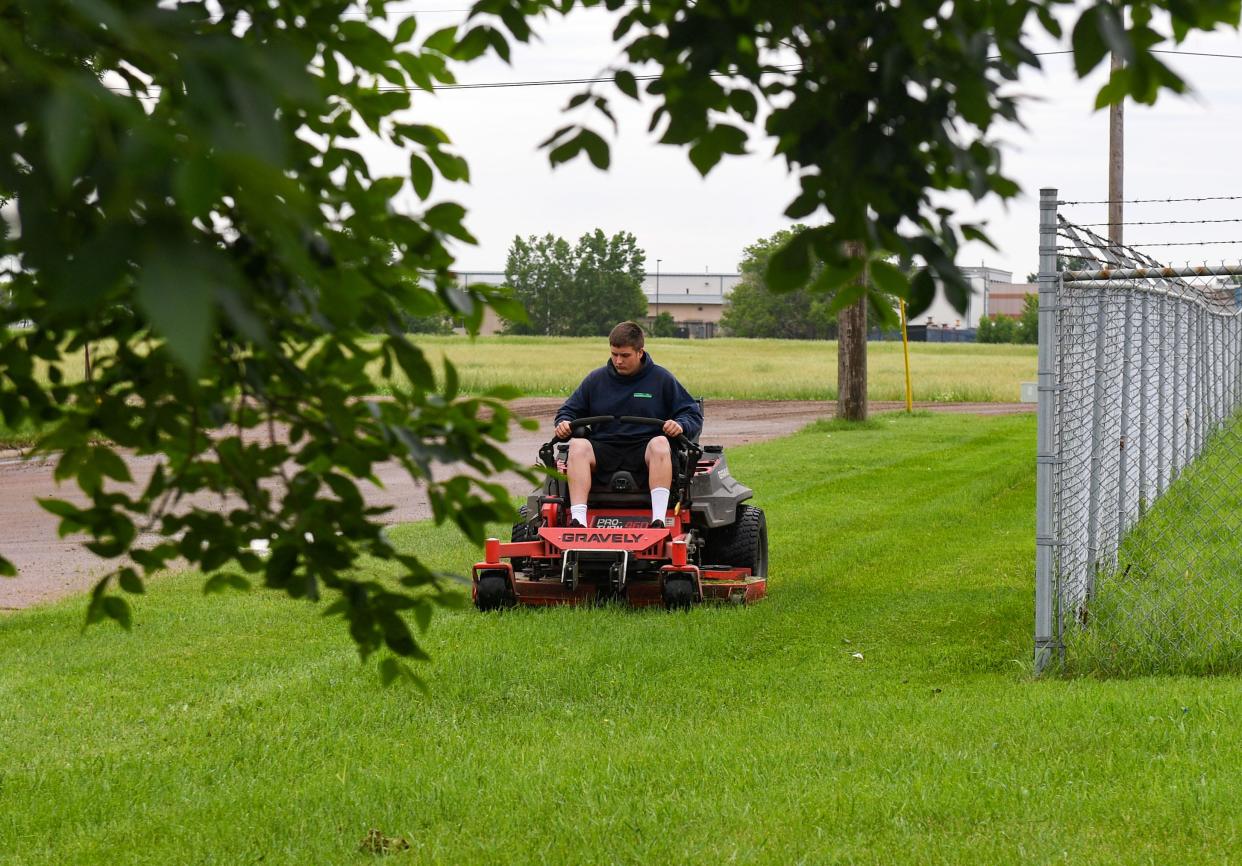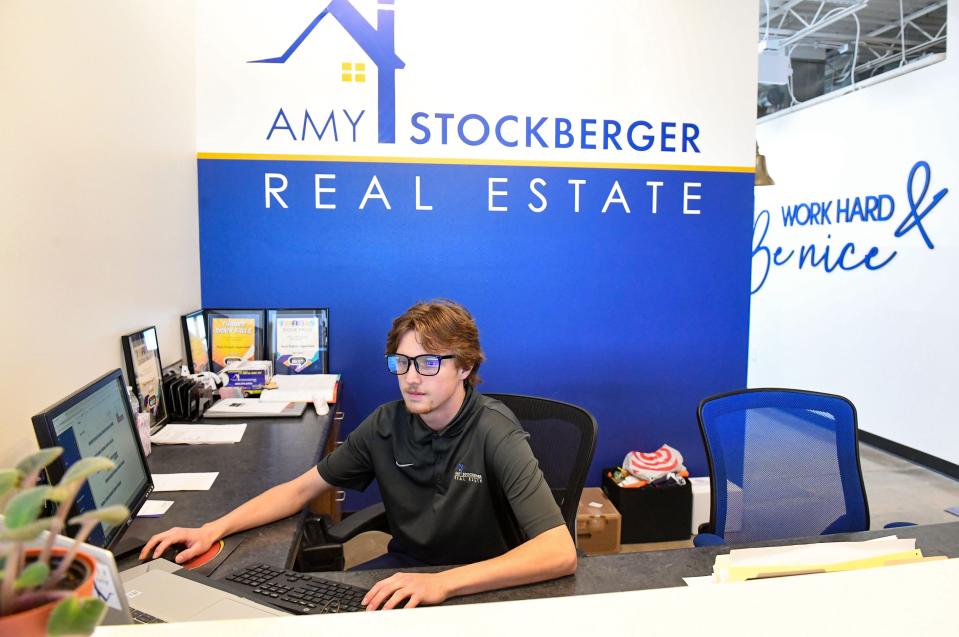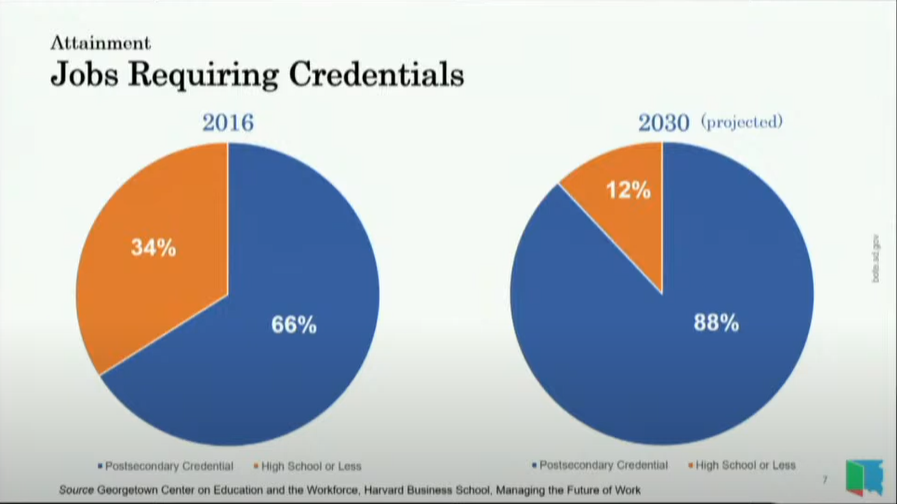Why nearly 36% of South Dakota’s high school graduates choose work over college

Why wait to make money when you can put money in your account now?
That’s what Tyler Arrowood asked himself around the time he graduated from Washington High School in May. He was considering either going to a two-year college, or working for his aunt and uncle’s lawn care company, Lawn & Snow Co. LLC.
Arrowood, 18, opted for the workforce because he enjoys the work, likes working with family and also isn’t a big fan of school, anyway.
His story is not uncommon, with nearly 36% of South Dakota’s high school graduates choosing a path that does not include higher education, according to the Department of Education’s State Report Card for 2020-2021. Data on where 2022 graduates go after high school won’t be finalized until the DOE’s report card comes out in the fall, spokeswoman Ruth Raveling said.
It makes sense that high school graduates in South Dakota would enter the workforce right away; the state is overflowing with job opportunities, wages are on the rise, some might opt to help on the family farm, some might be able to train for a high-paying job without having to go to college.
As of June 9, there were 29,400 jobs open across South Dakota, according to the Department of Labor and Regulation. South Dakota also has the second-highest labor force participation rate in the country, according to federal reserve data from November. South Dakota's minimum wage is $9.95 per hour, higher than the federal minimum wage of $7.25. And wages are growing in the state, according to the most recent quarterly census of South Dakota employers compiled by the DLR.
Couple that with the current near-historic lows in unemployment, 2% in Minnehaha County and a miniscule 1.7% in Lincoln County, and entering the workforce is that much more intriguing for high school graduates.
More: South Dakota sees low unemployment, record job openings in post-pandemic economy
Employers are continually telling the DLR about workforce shortages and the challenges they face when trying to hire workers, DLR Secretary Marcia Hultman said.
"One benefit of this is that South Dakota leads the nation in growth in personal income over the past two years,” Hultman said. “Our labor market is tight, with demand greatly outweighing the supply of workers, so rising wages are no surprise. Increasing wages is one way employers are trying to retain current employees and attract job applicants.”
Why South Dakota high school graduates choose the workforce
Jersey Fink graduated from Washington High School in May, and his dream is to become a realtor. Fink, 18, now works as an intern at Amy Stockberger Real Estate, doing administrative work and helping with paperwork and errands until he gets his realtor license.
“I had a thought process of going to Southeast Technical Institute,” Fink said. “I’m not a big fan of college. I was going to go there, and this job opened up in February. I had all my experience from the Career & Technical Education Academy with resumes and cover letters.”

He will pursue his real estate license within the next month, and said it was an “easy change” to go right to work after high school. He notes the hours are about the same as school, except a little longer.
“I think the coolest part (of this job) is being able to talk to people, communicate with them and help them during the happiest part of their life,” Fink said. “I love houses.”
More: 'A lot went into graduating high school': Class of 2022 on why graduation is important to them
Nicholas Levisay also graduated from Washington High School in May. After his years of playing in the WHS marching band, including leading the band as a drum major for two years, he got an unexpected offer from the band director, Kiley Coyne, for a job.
Levisay, 18, is now on staff for the band for the summer until he starts a year-long business apprenticeship program known as Praxis in September, which is advertised as a “college alternative that leads to a full-time job.”
He’s volunteered his time to build a new website for the marching band, and will start the WHS band job at the end of June, which will include helping the band with two-week long band camp where students learn their steps and the music simultaneously.
After his band duties are complete towards the end of August, Levisay will start the Praxis program, which consists of three months of virtual rigorous business training, three months of a long virtual process of looking at one’s passions and finding a good career, then six months of an apprenticeship anywhere in the country, Levisay explains.

“I’ve had a lot of different interests in my life, from animal care, marketing and real estate,” he said. “I’ll get a lot of good business experience from (Praxis), and useful skills no matter what I do. (Praxis) is a cool organization that will challenge me to learn more, and learn how to do better.”
More: Indigenous seniors celebrate major right of passage: high school graduation
Arrowood said he might possibly go for a 2-year business degree down the road, but for now, he’s just happy working with his aunt and uncle and taking care of lawns.
There is still a push to attend college
With so many immediate job opportunities, including some offering wages that could match or surpass wages college-educated employees make, the state’s postsecondary education systems are brainstorming ways to get more students in college.
Brian Maher, CEO and executive director of the SDBOR, said the Regents are trying to reverse the trend of declining enrollment, by improving retention rates and breaking down barriers for students to attend.
The Freedom Scholarship, a needs-based scholarship program, will help make college more affordable and accessible for many students, Maher said. The BOR is also helping high school students complete their FAFSA (Free Application for Federal Student Aid), which is an “incredibly daunting task” for students, Maher said.
The Board of Regents gave scholarships to 4,069 students during the 2021-2022 academic year, including South Dakota Opportunity, needs-based, Jumpstart, Dakota Corps and Critical Teaching Needs Scholarships, according to Kerri Richards, scholarship and financial aid policy analyst for the SDBOR.
As recently as 2007, the state covered more than 55% of the cost of students’ attendance, while students paid for 45%, Maher said in a May 12 Good Morning Sioux Falls meeting hosted by the Greater Sioux Falls Chamber of Commerce. But that’s fluctuated greatly, he added, explaining that students pay about 60% of their cost of attendance now, while the state covers about 40%.
Maher said he’s also grateful to the Legislature for increasing base funding to the public university system by $8.6 million with the 6% increase to education that Gov. Kristi Noem proposed, allowing the BOR to freeze tuition and fees this year.
More: Tuition at South Dakota's 6 public universities won't increase next school year
Maher also said in the May 12 meeting that adding a year of schooling to the average educational attainment of employed workers with at least a high school diploma is associated with an increase in real per capita GDP of 17.4%.
“It’s really critical that we increase the number of students who receive an education beyond high school,” Maher said.
He also added that higher education translates to lower incarceration rates, higher rates of charitable giving and volunteering in a community, higher rates of voter and civic engagement, healthier lifestyles, less reliance on welfare and social assistance programs and lower rates of unemployment.
“There’s a lot to be gained by investing in higher education as a state,” he said.
Two-year and technical schools can split the difference
That investment by the state also includes technical colleges governed by the South Dakota Board of Technical Education, and led by director Nick Wendell. He said the perception of the value of technical education is shifting, and students, parents, educators and industry leaders recognize that a technical education presents many career opportunities.
While nationwide enrollment in public two-year colleges nationwide has declined by more than 15% since the start of the pandemic, but Wendell notes South Dakota has bucked that trend, as enrollment has grown or at least stabilized in the BOTE in recent years.
More: Gov. Kristi Noem appoints first members to Freedom Scholarship Board
The Build Dakota scholarship program has also helped provide free-ride scholarships to students in one of nine high-demand fields to those who commit to work in South Dakota for three years after graduation, Wendell said.
It’s best to attend college right after high school, Wendell explained, because those students’ pathways will be smoother and the likelihood they gain a credential will also be higher. Wendell said there’s also support for nontraditional students in higher education, too.
And, for the less than 36% of South Dakota’s high school graduates who go on to higher education, “We can’t afford to leave (those) South Dakotans on the sidelines,” Wendell said in a recent Sioux Falls school board meeting. “We’ve got to find ways to bring more of them into the fold and access some type of valuable postsecondary credential.”
Wendell estimates that in 2016, 34% of jobs only required a high school or less education, and 66% of jobs required a postsecondary credential. But by 2030, he estimates 88% of jobs will require a postsecondary credential.
More: JAG dropout prevention program to expand to all 4 public Sioux Falls high schools next year

That being said, what matters most to Laura Scheibe, director of the division of college, career and student success at the SDDOE is that high school graduates find their passion, whether that's in the workforce or with postsecondary education.
"From my perspective, we're doing a good job in helping kids find their path, whatever that looks like for them," she said. "It's important for students to explore while they're in the K-12 system and find what's next. The numbers are the numbers, and kids have the opportunity to find what fits."
Options are always good for students
The DOE helps students find their passions through programs like dual credit, which lets kids "try on postsecondary" before they enter, Scheibe said; there's the state's robust Career & Technical Education system, which offers courses in various career areas; career exploration content standards; South Dakota Week of Work; Jobs for America's Graduates; middle school career camps; and, Career Launch, which connects students with the DOE and the Department of Labor and Regulation to career exploration.
While Maher recognizes the job market is one where graduates can enter at a higher level than they could “generally speaking,” he has one piece of advice he’d like to offer to recent high school graduates who are considering going straight to work after high school.
“Think about what the long term ramification of that is. Will that market always be like that? Or will there be a time where you're going to need to add more education than what you have to date, to retain in that job market?” Maher said. “That's a big issue. But without a doubt, the job market being what it is today has been a bit of a game changer for college-going students.”
This article originally appeared on Sioux Falls Argus Leader: Why 35.7% of South Dakota's high school grads choose work over college

